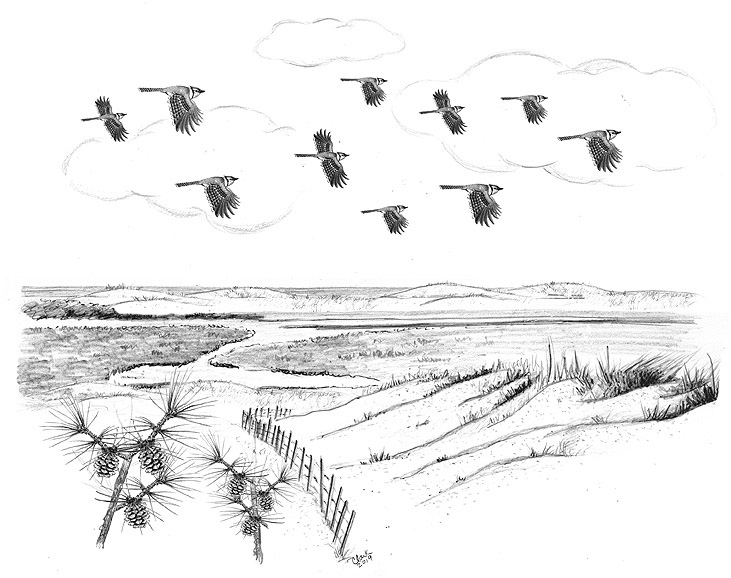
Dear Bird Folks,
I stopped at the Truro hawk watch last week and was surprised to learn that in addition to hawks, they also count migrating Blue Jays. According to Don, the head hawk watch guy, he had counted over 150 passing Blue Jays on that very day. Blue Jays? Do Blue Jays actually migrate? I thought they were always here.
– Phil, Harwich, MA
Yes, they do, Phil,
Blue Jays really do migrate and that bit of news seems to surprise a lot of people…including me. I remember being at the same hawk watch a while ago and when I saw several jays fly past I didn’t even blink. I just figured they were on their way to the nearest birdfeeder. But, Don, aka, “the head hawk watch guy,” carefully counted each one and wrote down the total on his clipboard. He told me that late May is a very busy time for Blue Jays on Cape Cod. Hmm. And just when I thought I knew it all.
Blue Jays seem to have everything going for them. How is that, you ask? To begin with, they are strikingly beautiful. I recall reading a column back in 2013, which stated that jays are the most attractive birds on Cape Cod. I can’t really argue with that statement, especially since I was the one who wrote it…and I still stand by it. In addition, jays are both personable and shifty at the same time. They always seem to be up to something, and they usually are. A traveler from Britain once asked me the name of the “big blue bird” he had just seen. I told him the bird is called a “Blue Jay.” He then replied, “They sure are cheeky buggers.” I couldn’t agree more.
Of course, not everyone appreciates these cheeky buggers. One of the major raps against jays is that they’ll occasionally raid other birds’ nests. While that’s true, most folks wouldn’t even know about this habit if it weren’t for that darn John James Audubon. In an effort to create a dramatic illustration, J.J. painted a small flock* of jays eating another bird’s eggs. This upset some people. News flash: A lot of creatures, including us, eat bird eggs; but because of Audubon’s painting, only jays get slammed for it. Where’s the justice?
*FYI: A group of jays is known as a “party.” That’s right, it’s a party of Blue Jays, and the name fits them perfectly.
The combination of their beauty and bad boy image makes the jays’ relations with humans complicated. And there is something else about these birds that is even more complicated. It’s their annual migration. Like you, Phil, I’m surprised that jays migrate at all. I understand why hummingbirds leave us (the flowers are gone), and why ducks head south (the ponds freeze up) and why warblers move out (there are no more insects to eat), but jays don’t depend upon any of those things. Since they eat everything, including acorns, nuts, berries, insects and snails (snails?), the lack of certain foods shouldn’t be an issue. They also eat from bird feeders (which is another reason why I like them so much). Maybe jays just hate cold weather. Nope. It can’t be the weather because they play in a domed stadium. Hold on. I’m thinking about the Toronto Blue Jays. Forget that last one.
The truth is, Blue Jay migration is poorly understood. Even the experts can’t figure it out. Here is what they know…or what they think know. For the most part, Blue Jays are year-round residents. Even if you live in northern Canada, you are likely to see Blue Jays in the winter. The harsh weather doesn’t seem to scare them away, at least not all of them. While most jays stay home in the winter, roughly 20% of them leave. Why do some leave? The knee-jerk explanation for this annual movement is the items I’ve just mentioned, lack of food or severe weather. But often jays leave no matter the conditions. In addition, the birds seem to rotate which ones leave and which ones stay. Banding studies confirm that some jays will fly south one year, but won’t migrate at all the following year. How the birds decide which jays remain in the cold and which ones fly to warmer locations is unknown, but I’ve heard rock, paper and perhaps even scissors are involved.
Whatever the reasons for this fall migration, thousands of Blue Jays make the return trip north each spring. But unlike most songbirds, which migrate under the cover of darkness, jays are diurnal migrants. That means, if the wind is blowing right, the hawk watchers in Truro may see hundreds of Blue Jays moving along with the hawks. The show is even more spectacular along the Great Lakes, where the count can be in the thousands. Talk about a “blue wave.”
The part that surprises me the most is how late in the spring jays travel. Their peak migration on Cape Cod is the last week of May. Meanwhile, those fragile little Ruby-throated Hummingbirds have flown all the way up into Canada and are building their nests by then. Why are jays so slow? Eating all those snails must be having an effect on them. Get it? Snails are noted for being slow, very slow and…never mind.
You aren’t alone with your questions about Blue Jay migration, Phil. Researchers have been scratching their heads over this very topic for years. Why some jays stay put and others head south, and why the spring migration is so late, is a mystery. But whether they stay or go, there’s one thing we know for certain about Blue Jays – they sure are cheeky buggers.